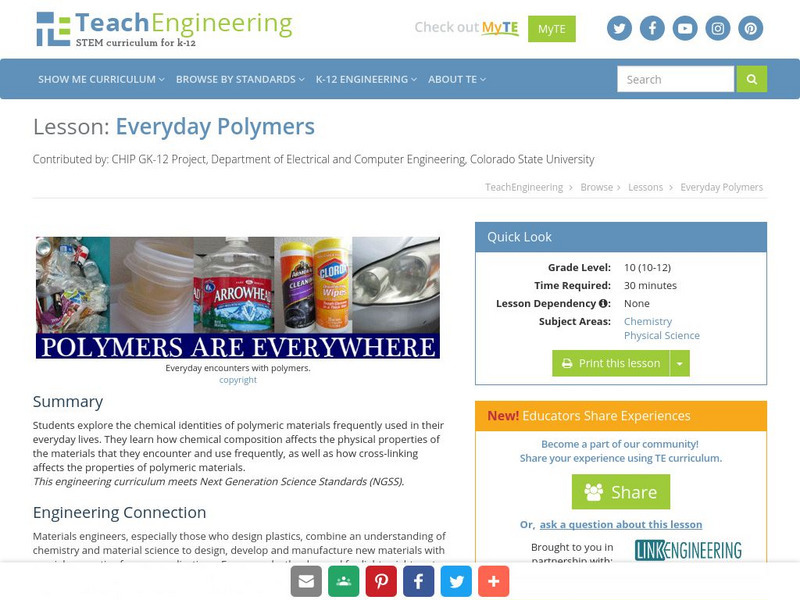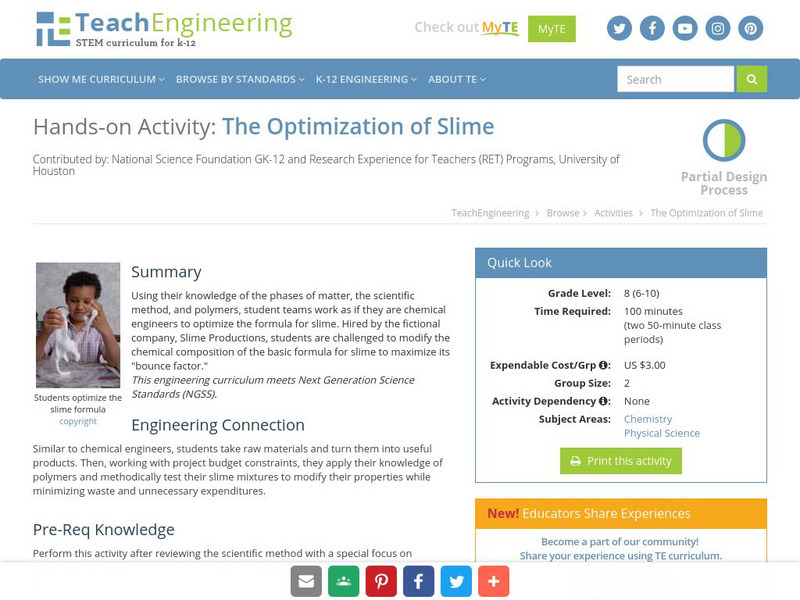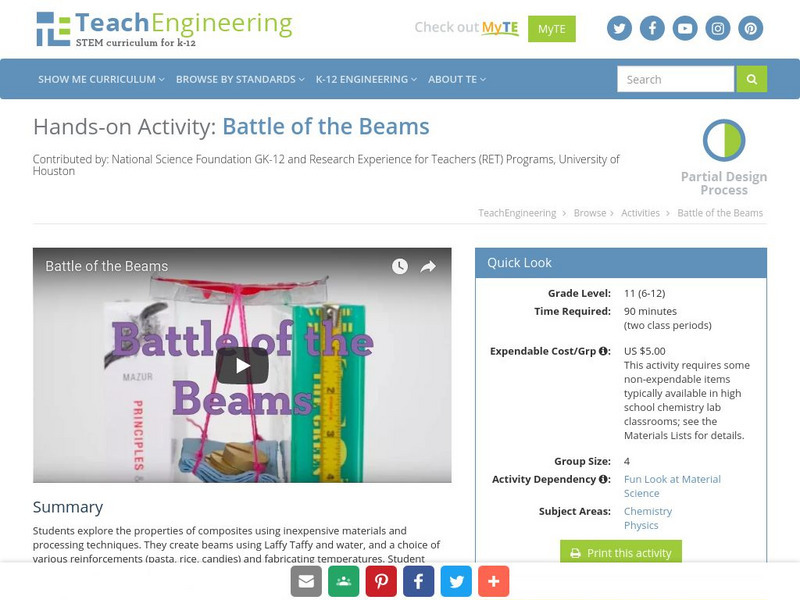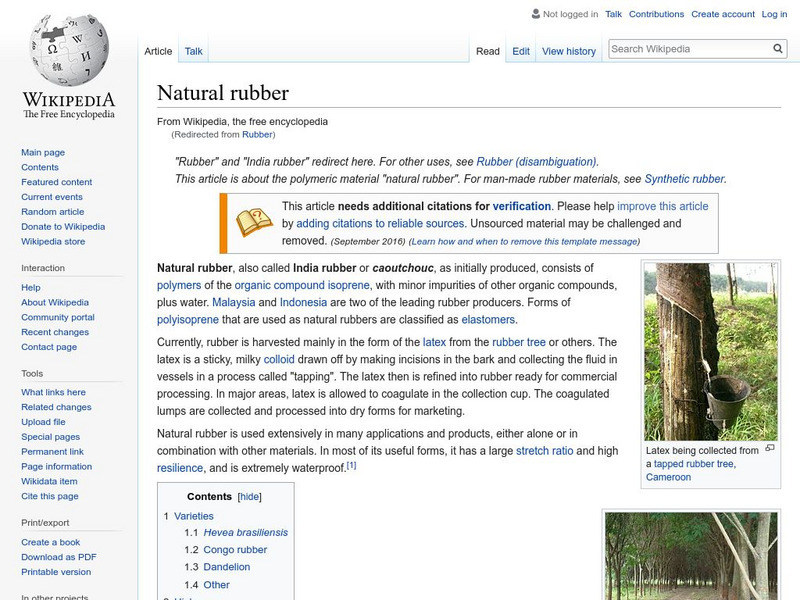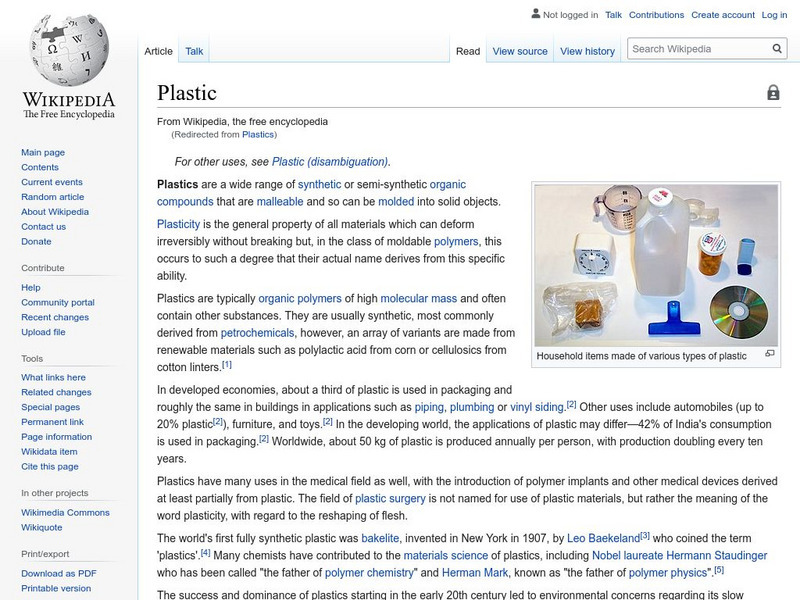Science Education Resource Center at Carleton College
Serc: Investigating Polymers: Comparing Two Liquid Glue Based Polymers
For this experiment, students will work in small groups to create two different polymers, similar to Flubber and Silly Putty, using Elmer's glue, liquid laundry starch, and Borax. They will then compare the properties of the two...
Science Education Resource Center at Carleton College
Serc: Mn Step: Where in the World Can I Find Plastic Polymers. Why Are They Used?
An investigation of where plastic polymers can be found in everyday life. After identifying them, students test them to learn about their properties, then try some online activities.
Science Education Resource Center at Carleton College
Serc: Polymers & Plastics: Classification & Models
Young scholars will use their prior knowledge about changes of matter including physical and chemical changes to examine and categorize various types of plastics (polymers). They will identify how their chemical properties allow them to...
Science and Mathematics Initiative for Learning Enhancement (SMILE)
Smile: Polymers: The Discovery
A simple lab activity which introduces the field of polymer chemistry. Includes the use of polystyrene in a neat reaction.
Chiral Publishing
Chiral Publishing: An Introduction to Chemistry: Organic Chemistry/biochemistry/synthetic Polymers Study [Pdf]
Use this site to get an overview of organic chemistry, biochemistry, and synthetic polymers. Also includes an answer key to the chapter review questions and links to online quizzes.
TeachEngineering
Teach Engineering: Everyday Polymers
Young scholars explore the chemical identities of polymeric materials frequently used in their everyday lives. They learn how chemical composition affects the physical properties of the materials that they encounter and use frequently,...
US Department of Energy
U.s. Department of Energy: Fuel Cell Technologies Program: Fuel Cell Animation
A series of animated illustrations show how a polymer electrolyte membrane fuel cell works. PEM fuel cells are the most common type used in flex-fuel vehicles.
TeachEngineering
Teach Engineering: The Optimization of Slime
Using their knowledge of the phases of matter, the scientific method, and polymers, student teams work as if they are chemical engineers to optimize the formula for slime. Hired by the fictional company, Slime Productions, students are...
University of Pennsylvania
University of Pennsylvania: Solid State Chemistry: Describing Crystalline Solids
This site contains in-depth information on crystalline solids. Includes basic concepts, pictures, learning graphs, and useful tools.
Other
Polythene: Production and Properties & Uses
A wonderful site for information on polythene. Contains a table of information for high density and low density polyethylene (LDPE and HDPE) which tells melting point, uses, chemical properties, and more for each. Also contains the...
TeachEngineering
Teach Engineering: Battle of the Beams
Students explore the properties of composites using inexpensive materials and processing techniques. They create beams using Laffy Taffy and water, and a choice of various reinforcements (pasta, rice, candies) and fabricating...
Science Education Resource Center at Carleton College
Serc: Plastic Polymers: Investigating Their Flexibility
Young scholars will use their prior knowledge about changes of matter to develop a hypothesis to test the physical properties of materials such as plastic (polymers) and how its chemical properties allow it to have unique physical...
Massachusetts Institute of Technology
Mit: Inventor of the Week: Roy J. Plunkett
Read about Roy Plunkett's invention, teflon, one of the best-known and most widely used polymers that was created by accident.
Massachusetts Institute of Technology
Mit: Inventor of the Week: Leo Baekeland
Use this site to learn about how Leo Baekeland invented plastic, and how this simple invention resulted in a "plastic revolution."
York University
Chemistry Hall of Fame: Polyethylene a Plastic of Many Uses
Background information on the discovery of polyethylene is found on this website. Also lists polyethylene's many uses.
TeachEngineering
Teach Engineering: Creepy Silly Putty
Students learn about viscoelastic material behavior, such as strain rate dependence and creep, by using silly putty, an easy-to-make polymer material. They learn how to make silly putty, observe its behavior with different strain rates,...
Wikimedia
Wikipedia: Rubber
Wikipedia provides detailed information on rubber, a hydrocarbon polymer. Includes information on the composition and uses of rubber.
Wikimedia
Wikipedia: Fuel Cell
A detailed Wikipedia encyclopedia article on fuel cells explains what they are, the controversies in the use of hydrogen as a fuel, and practical problems. There is also a lengthy section on the five generally recognized types of fuel...
Science Struck
Science Struck: Ldpe Plastic
LDPE stands for low-density polyethylene. This resource describes its structure, physical and chemical properties, resistance to various chemicals, advantages and disadvantages, uses, its BPA-free status, and the issue of recycling LDPE...
Other
San Diego Plastics, Inc.: Polyethylene
The features, applications, and the fabrication process of high density and low density polyethylenes are listed and described.
BiologyWise
Biology Wise: How to Make a 3 D Dna Model Project
Describes the steps for how to make a model of DNA using colored polymer clay and wire. Students will gain a good understanding of the structure of DNA by doing this project.
TeachEngineering
Teach Engineering: Surfactants: Helping Molecules Get Along
Students learn about the basics of molecules and how they interact with each other. They learn about the idea of polar and non-polar molecules and how they act with other fluids and surfaces. Students acquire a conceptual understanding...
TeachEngineering
Teach Engineering: Flocculants: The First Step to Cleaner Water!
Students experience firsthand one of the most common water treatment types in the industry today, flocculants. They learn how the amount of suspended solids in water is measured using the basic properties of matter and light. In...
Wikimedia
Wikipedia: Plastic
Wikipedia offers all of the basic information one would need about the topic of plastic. Includes hyperlinked table of contents for easy site navigation.



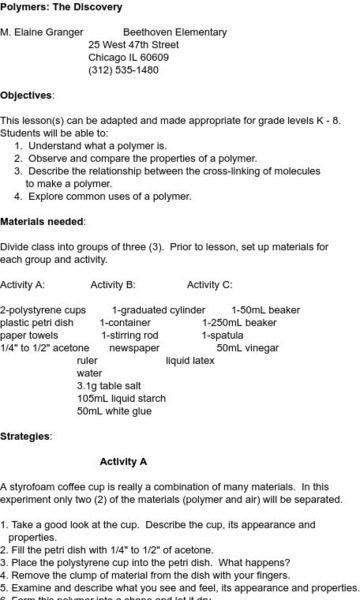
![Chiral Publishing: An Introduction to Chemistry: Organic Chemistry/biochemistry/synthetic Polymers Study [Pdf] eBook Chiral Publishing: An Introduction to Chemistry: Organic Chemistry/biochemistry/synthetic Polymers Study [Pdf] eBook](https://static.lp.lexp.cloud/images/attachment_defaults/resource/large/FPO-knovation.png)
